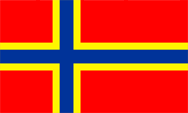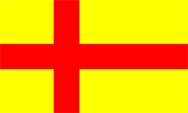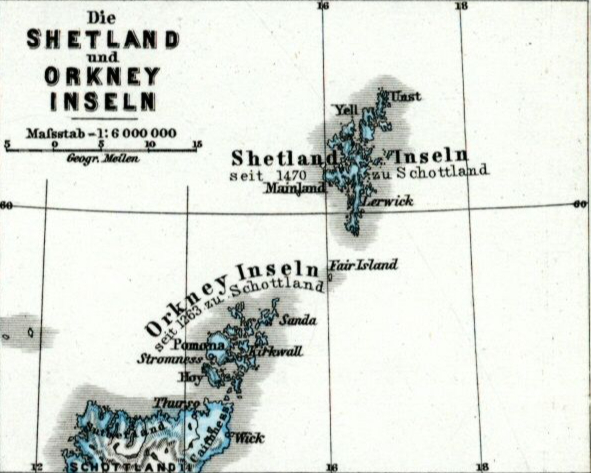mobile View, to the German Version tap the flag


- Scottish Unitary Authority (Council Area) and Lord-Lieutenancy
- own names:
– English: Orkney
– Scottish Gaelic: Arcaibh
– Old Norse: Orkneyjar
• Flag
• Historical Flag
• Meaning/Origin of the Flag
• Coat of Arms
• Meaning/Origin of the Coat of Arms
• Map
• Numbers and Facts
• History
• Origin of the Country's Name

since March 2007,
Flag of the Orkney Islands
ratio = 3:5,
Source, by:
Wikipedia (DE)







ca. 1995 to March 2007,
unofficial Flag of the Orkney Islands,
ratio = 3:5,
Source, by:
Wikipedia (EN)






Orkney, an island group off Scotland's north coast, is peopled by folk of Norse descent, hence the flag (the colours are inspired by Scotland's Royal Standard). It was granted to the Kingdom of Scotland by Norway as part of a marriage dowry in the 15th century. A Norse dialect, called Norn, was spoken here until the late 19th century. As a result of this differing history, it's likely that if ever Scotland gains its independence, Orkney and Shetland may well go their own way. Orkney also has the greatest concentration of Stone Age archaeological sites in Europe.
Source, Zitat: Stateless Nations
The yellow flag with the red cross was always unofficial, and the use was even forbidden in accordance with jurisdiction of the Lord Lyon King of Arms in Great Britain and especially in Scotland, because the right for using of such a flag by colour and form – red Scandinavian cross on yellow ground – is only allowed the Earl of Londonderry in accordance with a coat of arms patent from the 19th century. Because of that was introduced a new flag in March 2007.
Source: Wolfgang Schlick:
www.schottlandportal.de,
www.northernisles.schottlandportal.de
The flag was introduced in March 2007 and shows also a Scandinavian design. It is a combination of the colors of Norway and Scotland, and in this way should point out to the historical ties with both countries.
Source: Wikipedia (DE)


Coat of arms of the Orkney Islands,
Source, by:
heraldry-wiki.com

The Orkney Islands coat of arms was created in 1975. The shield is parted per pale between red and blue, it shows a ship of the Sinclair clan in the blue field and the Norwegian lion in the red field.
Source:
Wikipedia (EN)

Location:

Source: Freeware, University of Texas Libraries, modyfied by: Volker Preuß
Map of the Orkney und Shetland Islands:

Source: Hand-Atlas für die Geschichte des Mittelalters und die neueren Zeit, von Spruner und Menke

Area: 382 square miles
Inhabitants: 20.110 (2010)
Density of Population: 53 inh./sq.mi.
Capital: Kirkwall, 7.045 inh. (2011)
official Language: English
other Languages: Scottish Gaelic, Scots (Lallans)
Time Zone: Greenwich Meantime = CET – 1 h
Source:
Wikipedia (DE)

ca. 400 B.C. · immigration of Celtic tribes toward the islands
ca. 700–800 · Vikings capture the Orkney Islands and those become a county of Norway
995 · beginning of conversion to Christianity
1263 · defeat of the Norwegians at Battle of Largs, gradual decline of Norwegian influence on the islands
1468/1469 · Christian I., king of Denmark and Norway, pledges the Orkney and the Shetland Islands for the dowry of his daughter Margaret, as assurance for the marriage with James III. king of Scotland, the Orkneys are annexed by the Kingdom of Scotland
1472 · the pledge gets redeemed, Scotland annexes the islands
1611 · the Danish law gets abolished
2023 · in Orkney, official consideration is being given to annexing the islands to Norway, either as a Norwegian Crown Dependency (comparable to the status of the islands of Guernsey and Jersey) or as a Norwegian overseas territory
Source:
Atlas zur Geschichte,
Discovery '97,
Wikipedia (DE),
Der Spiegel

The origin of the name of the islands is unknown, however there are some theories:
1st theory: The name of the Orkney Islands reveals that there have been many whales in earlier times, because the Celtic word "orc" means "whale" and the old Norwegian word "ey" means "island". They are the Whale Islands.
Source: Handbuch der geographischen Namen
2nd theory: The islands' Latin name, Orcades, derives from the Celtic word "ork", meaning "young boar".
Source: Wikipedia (DE)
3rd theory: The name of the islands goes back to a name that the Norwegians gave to seals at the time, namely: "Orkn". So they are called "Orkneyjar" in Old Norse, which would then mean "Seal Islands".
Source: Wikipedia (DE)


![]()












